Excerpts from Jim Conrad's
Naturalist Newsletter
from the November 13, 2016 Newsletter issued from Rancho Regenesis in the woods ±4kms west of Ek Balam Ruins; elevation ~40m (~130 ft), N20.876°, W88.170°; north-central Yucatán, MÉXICO
SWORD BEAN
When Carlos the young engineer was at the rancho working on permaculture projects he ordered some Pigeon Peas, Cajanus cajan, because he'd read that that member of the Bean Family spreads across the ground, providing good cover. He planted the seeds around the Papayas, hoping the resulting ground cover might keep the soil from drying out, making the papayas more productive.
However, what came up from those seeds wasn't the expected much-branched, ground-running Pigeon Pea, but rather a very robust vine with a slender stem that twisted around in the air searching for support on which it could climb skyward. The workers put up poles for them to climb, and below you can see what they look like now:
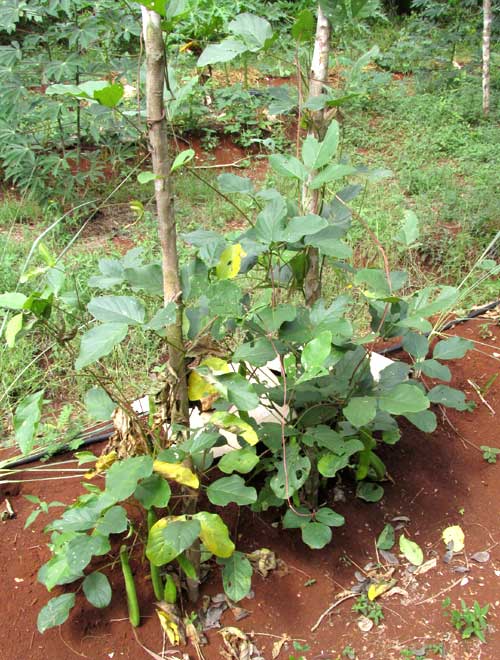
From the beginning, these vines displayed amazingly fast growth and produced big leaves and fruits. You can see one of their large, trifoliate leaves, structured very like the leaf of a common garden bean but much larger, as you can see below by comparing its size with my hand
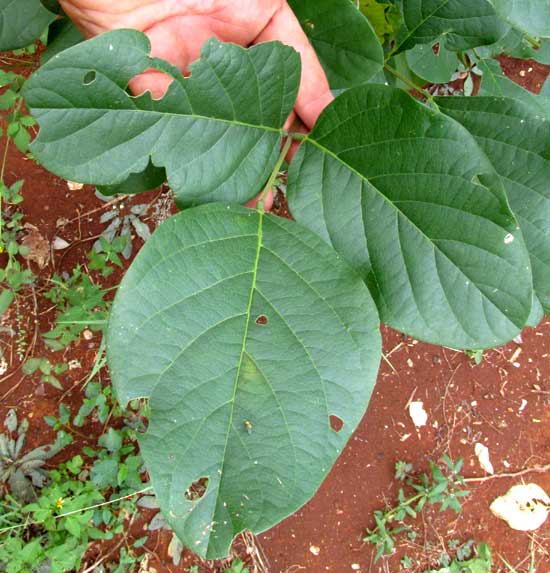
Once the vine began to flower, it was easy to identify it not as the expected Pigeon Pea, but rather the Sword Bean, CANAVALIA GLADIATA, a native of the Old World tropics. You can see one of its sizable flowers below:
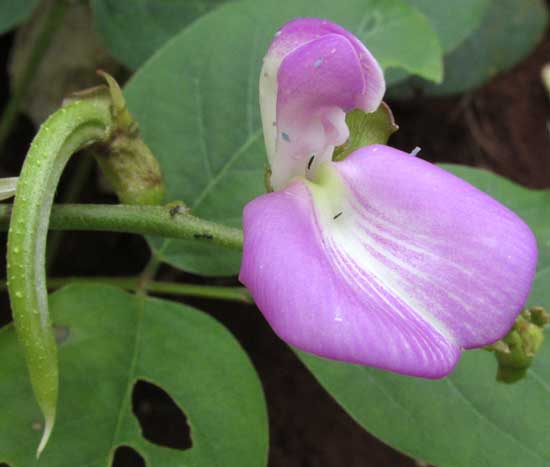
The flower's general structure is "papilionaceous," the same as most flowers in the Bean Family, except that the Sword Bean turns its flowers upside-down. Its large "banner" or "standard" petal, which on flowers of most Bean Family members rises above the blossom to attract pollinators, here flairs out at the flower's base. As such, it serves as a pollinator landing pad equipped with white-stripe "nectar guides" pointing to the flower's throat where nectar is available. The scoop-shaped "keel," which in most papilionaceous flowers lies at the blossom's bottom, in this flower rises above the blossom like a curving crest. A side view of the flower showing its two-lipped calyx is shown below:
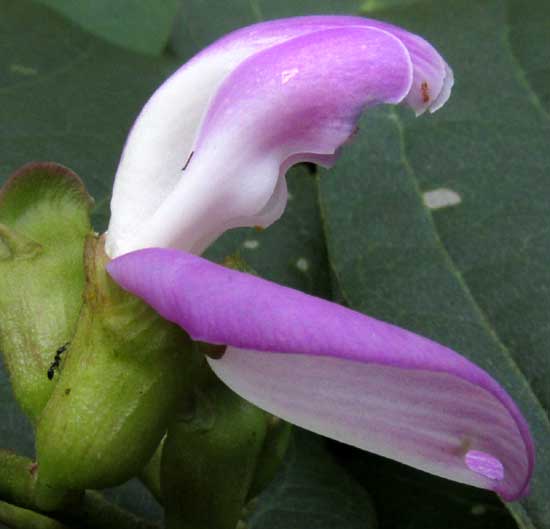
It's the Sword Bean's huge, legume-type fruits that really catch attention, though. You an see some below:
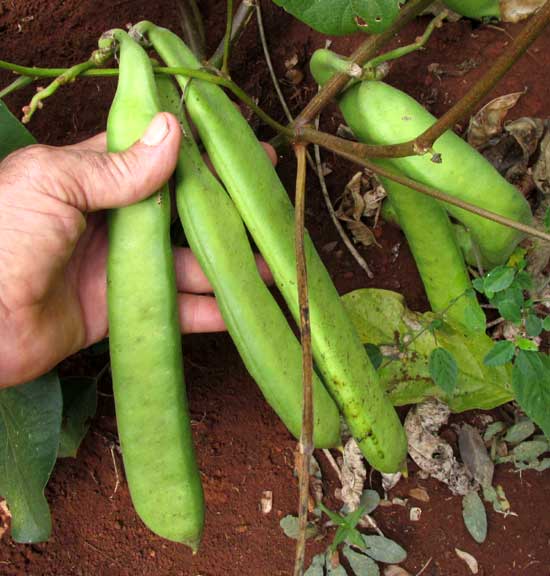
An opened pod with beans inside it is shown below:
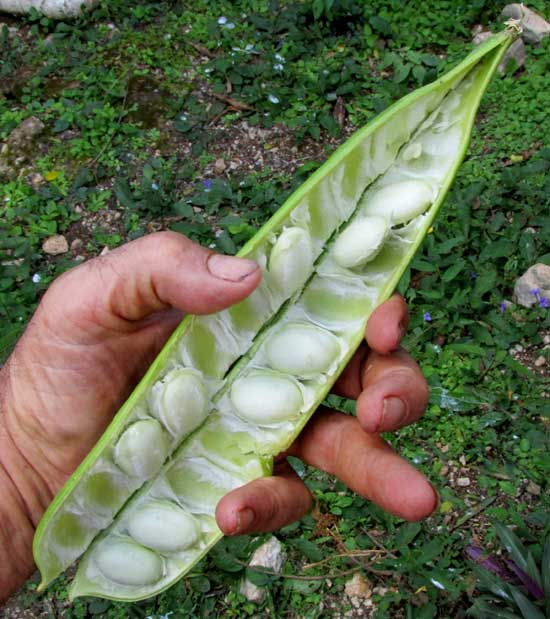
The beans are so similar to Lima beans that I had to give them a try. I found that with normal cooking they don't soften like Lima beans, and don't absorb the broth and its flavors. They tasted a little uncooked and remained somewhat tough and greenish. On the Internet, "Grower Jim" at BlogSpot.Com suggests letting the bean pods mature and dry, then shell the seeds and cook them. He says that the dried seeds then must be soaked overnight and thoroughly cooked in 2-3 changes of water, to rid the beans of potential toxins.
At the Feedipedia.Org website I read that in Madagascar the vines' young, green fruits and immature seeds are cooked as vegetables. Wanting to try this way of eating them, I picked the immature legumes shown below:
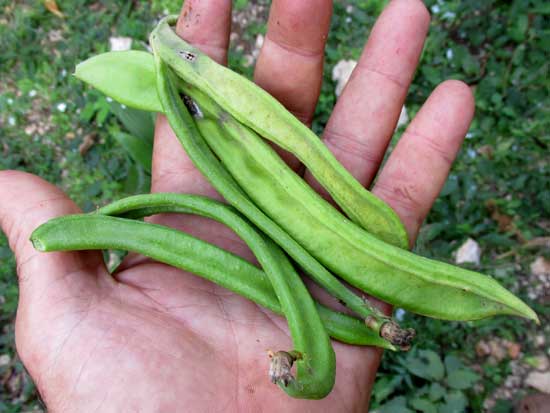
When those pods were sliced into small trapezoids and sauteed with onion and chili to make a kind of omelet, it turned out pretty well. The pod sections were chewy but not leathery. They didn't have much taste, but when they're fixed with onion and chili it's enough for them to be green and nutritious.
At the rancho, Sword Bean may end up being more of a livestock fodder and nitrogen-producing ground cover than something we humans eat. The Feedipedia.Org website reports that in various tropical countries the beans are used as feed for cattle and chicken, though if eaten in considerable quantity dry seeds may cause poisoning. The vine itself is a perennial, though usually it's cultivated as an annual, and can reach up to 10m long (33ft). The rancho's burros and cattle show no hesitation about gulping down Sword Bean's beans, pods, and vines with roots.